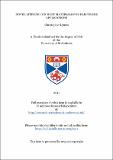Novel lithium-ion host materials for electrode applications
Abstract
Two novel lithium host materials were investigated using structural and electrochemical analysis; the cathode material Li₂CoSiO₄ and the LiMO₂ class of anodes (where M is a transition metal ion).
Li₂CoSiO₄ materials were produced utilising a combination of solid state and hydrothermal synthesis conditions. Three Li₂CoSiO₄ polymorphs were synthesised; β[subscript(I)], β[subscript(II)] and γ₀. The Li₂CoSiO₄ polymorphs formed structures based around a distorted Li₃PO₄ structure. The β[subscript(II)] material was indexed to a Pmn2₁ space group, the β[subscript(I)] polymorph to Pbn2₁ and the γ₀ material was indexed to the P2₁/n space group. A varying degree of cation mixing between lithium and cobalt sites was observed across the polymorphs.
The β[subscript(II)] polymorph produced 210mAh/g of capacity on first charge, with a first discharge capacity of 67mAh/g. It was found that the β[subscript(I)] material converted to the β[subscript(II)] polymorph during first charge. The γ₀ polymorph showed almost negligible electrochemical performance. Capacity retention of all polymorphs was poor, diminishing significantly by the tenth cycle. The effect of mechanical milling and carbon coating upon β[subscript(II)], β[subscript(I)] and γ₀ materials was also investigated.
Various Li[subscript(1+x)]V[subscript(1-x)]O₂ materials (where 0≤X≤0.2) were produced through solid state synthesis. LiVO₂ was found to convert to Li₂VO₂ on discharge, this process was found to be strongly dependent on the amount of excess lithium in the system. The Li₁.₀₈V₀.₉₂O₂ material had the highest first discharge capacity at 310mAh/g. It was found that the initial discharge consisted of several distinct electrochemical processes, connected by a complicated relationship, with significant irreversible capacity on first discharge.
Several other LiMO₂ systems were investigated for their ability to convert to layered Li₂MO₂ structures on low voltage discharge. While LiCoO₂ failed to convert to a Li₂CoO₂ structure, LiMn₀.₅Ni₀.₅O₂ underwent an addition type reaction to form Li₂Mn₀.₅Ni₀.₅O₂. A previously unknown Li₂Ni[subscript(X)]Co[subscript(1-X)]O₂ structure was observed, identified during the discharge of LiNi₀.₃₃Co₀.₆₆O₂.
Type
Thesis, PhD Doctor of Philosophy
Collections
Items in the St Andrews Research Repository are protected by copyright, with all rights reserved, unless otherwise indicated.

